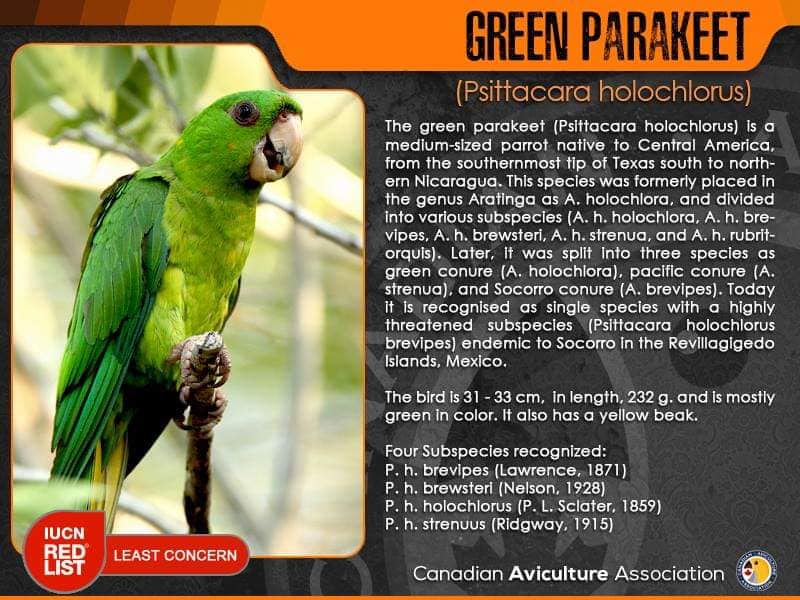Green Parrot - Psittacara Holochlorus - Least Concern
The green parakeet (Psittacara holochlorus) is a medium-sized parrot native to Central America, from the southernmost tip of Texas south to northern Nicaragua. This species was formerly placed in the genus Aratinga as A. holochlora, and divided into various subspecies (A. h. holochlora, A. h. brevipes, A. h. brewsteri, A. h. strenua, and A. h. rubritorquis). Later, it was split into three species as green conure (A. holochlora), Pacific Parakeet (A. strenua), and Socorro Parakeet (A. brevipes). Today it is recognised as single species with a highly threatened subspecies (Psittacara holochlorus brevipes) endemic to Socorro in the Revillagigedo Islands, Mexico.
Description: The bird is 32 cm in length, and is mostly green in color. It also has a yellow beak. The bird feeds on seeds, various fruits, and corn. It can sometimes be considered a crop pest. Wild birds primarily use scrub and swamp forests, woodlands, and forest clearings. The US population takes advantage of palm groves in cities.
Ecology: Green parakeet pairs usually find holes in trees in which to nest, where the female lays three or four eggs. It also nests colonially in crevices on cliff faces. After the breeding season is completed, the birds form large communal roosts.
Distribution: The species occurs from southern Texas and northern Mexico (including P. h. brevipes on Socorro Island) south through the Middle American isthmus to southwestern Nicaragua. It inhabits a variety of woody habitats. In western Nicaragua, their nesting sites lie within the El Chocoyero - El Brujo Protected Area, but the birds still face threats from the outside world when they leave the reserve to feed.
The A. brevipes subspecies is highly threatened by habitat loss due to feral sheep and predation by feral cats. Surveys from 2006 and 2007 estimated a population around 300 individuals, suggesting a population decline from previous population estimates.
The status of populations in southern Texas is unclear, with some claiming them to be feral escapees. However, the groups in the Rio Grande Valley are now generally regarded as naturally occurring because of the proximity of confirmed native populations, the deforestation of Tamaulipas which forced them to disperse, and earlier evidence from 1911 of these parakeets consuming a strawberry harvest at Combs.
It has become an invasive species around the world, as well. It has been sighted in the Iberian peninsula, probably of birds that escaped from their owners and return to the wild.

Psittaciformes, The Parrot Index, a part of Phoenix Feathers © 2016 - 2023
Page last updated: 12/24/23
Phoenix Feathers

